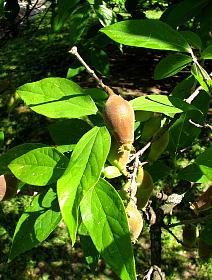Wintersweet or odorous Wintersweet, Chimonanthus praecox, Chimonanthus fragrans
Bush of the family Calycanthaceae
 Etymology: Chimonanthus comes from Greek Cheimonas, which means "winter", and anthos, "flower", in other words "which flourishes in winter", and it is well the case of this shrub. Etymology: Chimonanthus comes from Greek Cheimonas, which means "winter", and anthos, "flower", in other words "which flourishes in winter", and it is well the case of this shrub.
Praecox is a Latin word which became "precocious", in reference to winter blossoming.
Origin: the genus Chimonanthus includes 6 species of deciduous or persistent shrubs, native to hilly forests of China, between 500 and 1100m of altitude. It was introduced into England by 1766.
Habitat: Wintersweet makes the best of almost all soils, even calcareous, but cool, humus and well drained, but it prefers siliceous soils. It prefers a sunny position, sheltered from the wind. Wintersweet tolerates spray.
Hardiness: zone 6 (until -23 °). Under very cold climate, it is recommended to plant it against a wall which will return the heat of the sun, this to favour growth and blossoming.
Height: 3-4 m tall.
Rate of Growth: slow.
Shape: upright. Branches are raised then drooping.
Trunk: It includes a swelling of the low part (called "Caudex") constituting a body of water storage for the plant. It can reach nearly 1m in diameter..
Foliage: deciduous. Elliptical, opposite, simple leaves, acuminate, clearer-veined. They are 7 - 15 cm long on 2 - 12 cm broad. They are tough and harsh, and turn yellow in autumn.
Flowers: small flowers (1,5-4 cm in diameter), in the form of cut, axillaries, pendulous, waxen, sweet-scented (hyacinth or honey smell), bisexuals. They are formed by pale yellow waxy petals and almost translucent , 5-7stamens.
They appear in winter, from December to March, on the branches of the previous year.
Fruits: False woody fruits beige made darker of 6 cm long on 2,5 cm in diameter,urn-shaped with a narrower mouth in the apex, containing 5-8 true fruits bright brown, coriaceous of 2 cm long on 0,5-0,7 cm in diameter. These containers, when dry, often persist one year on the shrub.
Toxicity: the seed contains a toxic alkaloid, a calycanthine, which can cause convulsions.
Uses:
Wintersweet is a shrub appreciated for its fragrant winter blossoming. Its caudex allows an original use in dry rocks open-air.
In the Chinese traditional pharmacopeia the bark and roots were used to treat on influenza, as well as on rheumatisms. We extract from flowers an oil used in perfumery in Japan.
Propagation:
by seedling (in May), cutting (in July-August) or layering (in spring). It needs between 5 and 20 years for a plant from seedling to flourish. The layering is done by laying down twigs in the ground, before slightly incised at the rod in the ground to encourage the emergence of roots.
Advices of maintenance:
Yellow leaves are a chlorosis sign which it is necessary to correct with a watering based on iron chelate, or even a replacement of substrate.
Pruning is useless, because Wintersweet flourishes on the ancient wood. If a pruning is really necessary, to limit its expansion, it is necessary to perform it after blossoming.
Other species:
Chimonanthus campanulatus: shrub with persistent foliage and branches slightly pubescent, 3-5 m tall, yellow flowers without fragrance.
Chimonanthus grammatus: shrub with persistent foliage, 4-5 m tall, yellow flowers.
Chimonanthus nitens: shrub with persistent foliage, 2-6 m tall, small yellow flowers very pale or white-yellowish.
Chimonanthus salicifolia, Wintersweet with willow leaves: meets in China in the province of Kiang-Si.
Chimonanthus zhejangensis or Chimonanthus du Zhejiang: shrub with persistent foliage.
Hybrids:
Chimonanthus praecox var.grandiflorus ' Concolor ' has daffodil flowers.
Chimonanthus praecox var.grandiflorus ' Luteus ' has flowers gold yellow and crimson red.
|